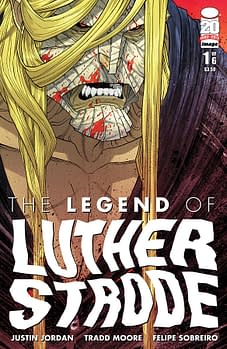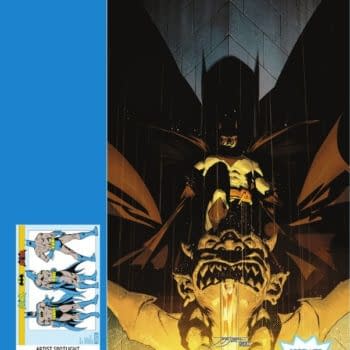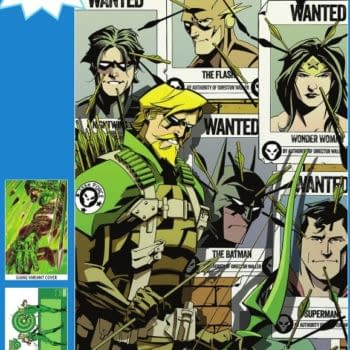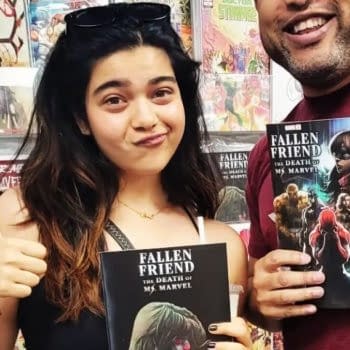Posted in: Comics, Recent Updates | Tagged: Comics, john layman, nick spencer
Image Creators Respond To Second Printing Kerfuffle – John Layman, Nick Spencer, Jim Zubkavich and Justin Jordan

But before the letter was widespread, I asked a number of Image creators how they felt about the situation, even having their own second printings restricted by their publisher.
I thought they were still worth sharing.
John Layman, writer of Chew, writes;
I *think* CHEW sells out every issue, and at a pretty rapid pace. Usually an issue that debuts on Wednesday is sold out the next Monday, as I understand it. And, yet, our numbers remain relatively stable, which I suppose is better than then shedding numbers. It's frustrating that this never translates into significant increased sales, or rising numbers, even when we anniversary issues or do thinks like offer free trifold posters.
Of course, our digital numbers are bonkers, as are our trade numbers, which may be a result of a changing marketplace. But it may also be that the book sells out too quickly and people seek out alternate means of getting it other than the monthly issues.
Either way, CHEW is far more successful than I ever dreamed it would be, and I have zero business sense, so this is something that's not exactly my area of expertise. I certainly share Images annoyance that all the sell-outs never translate into any sort of consistent rise in numbers.
When asked what would happen if he wanted a second print on an issue of Chew, but Image didn't, he told me
No idea. In general, I trust Image's business sense, particularly Eric Stephenson, more than mine. I usually default to what Image wants. Or maybe use Kirkman as a tie-breaker. He's pretty business savvy, too, considering he's a big, bearded, backwoods Kentucky rube.
Jim Zubkavich of Skullkickers, and now Birds Of Prey, told me;
Skullkickers isn't a world-beating popular title, so it won't be affected.
Now, Uncanny Skullkickers may be a whole different situation come February… I guess we'll wait and see.
Nick Spencer of Morning Glories replied;
What's getting lost here is the good news– this past year, we've seen the needle move significantly in terms of the sales of creator-owned books. There is a positive, fast-moving trend-line here, and it says if you produce quality, original work, you can find a home in the current marketplace. That's something we should all be celebrating right now, and something I'm very thankful to our retail community for.
Now, that said, I worry this conversation is devolving into finger-pointing: "You're not ordering enough," versus "You're not printing enough." And both sides have cases to make. However, I'd point out that some folks aren't quite grasping how the Image model works. The publisher isn't the one taking the risk when it overprints– the creators are (at least for the most part). We get paid based on sales, after costs. More printing equals more costs. Significant costs. So upping print runs can mean working for free for years instead of months, and in some cases, not getting paid at all. That's just not going to be feasible for most creators.
So let's be sure to be fair about who's being asked to do what in this instance. And it gets more complicated than that. You're asking the creator to overprint, but they have no control over the sales, end of the day. For instance, Creator A says, my trade is coming out, but orders are down on the single issue that comes out a week later. Should they overprint? We all do, by 10-20 percent, but more? Well, you're making not one but two leaps of faith there– one is that you're right about the consumer demand. Fine, we believe in the work, go for it. But the second is that x number of retailers will go back and re-order when their shelf copies run out. This is by no means a given. Plenty will just take the sell-through and move on. That's a very scary risk, and remember, you're taking it 1000 or so times, because you're not assuming it for one retailer, you're assuming it for all of them.
And that's maybe the most important part, which is the risk mitigation. For a retailer, let's say there are two dozen, maybe three dozen creator-owned single issue books you might be under-ordering on by a handful of copies– the shelf copies are gone, a couple people have asked about it, etc. Now, don't get me wrong, I know that's a very real, dollar amount risk, upping the numbers there. But it's also done within the context of a broader inventory that you've designed by nature to absorb some risk– no one gets their orders right all the time, obviously. It's done with additional options in reserve to at least recoup some potential loss– discounts, dollar bins, buy two get one free deals, etc.
For the creator, however– this one book might very well be all they have. There is no broader base to absorb the loss if one is incurred. There's no backup plan, and again, you're doing it in huge, huge numbers. It's the difference between playing a couple chips and going all in.
Which is, again, not to minimize the difficult spot the retailer is in. I mean, that's what this all really comes down to– I've worked with too many great retailers to think any numbers drop on a book comes from malice, laziness, or ineptitude. It comes from everyone involved having very tough decisions to make with their very limited resources. I'm just trying to explain, from my perspective, why 50 percent overprints are not happening. The risk simply can't be taken or absorbed by the creators– the books, and this model even, would simply cease to exist, end of story. That much I am absolutely certain of.
But there's a second part to this that I suspect is far, far more important. I have always approached creator-owned work with the primary goal being to create something that's lasting, and sustainable, for years. That means lots of things: no fill-in, inconsistent art. The story is the number of pages it needs to be. Double-sized first issues at standard cover, with 99 cent reprints and free digital samplers. $9.99 first trades with a lot of pages. These things are big-time loss leaders. We do them because the goal is not to grab cash, slump, cancel, and relaunch/do something else. We're playing a long game, and try to do things that help retailers build a consistent, long-lasting product for their shelves.
The simple reality, though, is the market is not really built around books that take this approach. All the focus is put on first issues, first arcs– big, quick returns. Most comics are published with this mind, but many Image books aren't. And when you apply the ordering patterns of a "sprinter" book to a "marathon" book, well– it doesn't usually serve you well on the latter. Cutting orders after a skip month sends a message that it would be better to do a fill-in; but we all know that, long-run, those fill-ins will stand out and detract from the overall book and the collections, having negative sales impacts long term. Not upping (or even cutting) orders after a trade release means the book is on a dangerous path to becoming a collection-only purchase, rather than using the trade to move readers over to singles.
The bottom line is the ordering pattern, the marketing approach, the pricing, the schedule– it really does differ depending on what your goals are in terms of the lifespan of the work. And this something that we all– retailers, publishers, and creators need to talk about, because it cuts to the core of what we're making and selling. Are we pushing out disposable, flash in the pan impulse buys, or are we trying to build stories that can last for years? My sincere hope is that we continue to see more of the latter, but making that happen will require new ideas and new solutions so that we're in all the best position possible to serve our customers and our readers.
And Justin Jordan posted on the V;
If every issue goes back into reprints after a substanial overprint then I don't think it's unreasonable to be frustrated by retailers being unable or unwilling to order at the levels they need. That's not a matter of the book's sales declining and the retailers ordering less – it's not ordering enough when they should know better.
And Image does indeed overprint pretty substanially. For example, the overprint on Luther Strode was something like thirty percent. And if we didn't sell out? Well, I have to pay for that shit. But if you're a retailer and can't get your orders within 30% on a book like Saga (not my book, mind, where ordering uncertainty is not unreasonable), you are doing it wrong. And since the books are not growing by the overprint each month, it means they are being continually under ordered.
Which places more of an onus on Image and the creators than it does on any individual retailer. So the position is not, I think, unreasonable.
On the other hand, I am not especially keen on my book being included in there. For one thing we ARE doing second printings when needed (as with the first issue of Legend), but beyond that, the orders for Legend were substanially higher than they were for Strange Talent, which means that at least some retailers were taking a leap of faith. And likewise, because of that, a drop of 21% for the second issue is by no means bad.
Plus, I'm not keen on the tone. Image has a point, but being antagonistic about it is not the way to go to address it. Especially when they're mentioning my book by name in that post.











